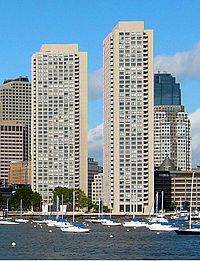Harbor Towers
This article has multiple issues. Please help improve it or discuss these issues on the talk page. (Learn how and when to remove these template messages)
|
| Harbor Towers | |
|---|---|
 A view of the Harbor Towers from Boston Harbor | |
 | |
| General information | |
| Type | Residential |
| Architectural style | Brutalist |
| Location | East India Row, Boston, Massachusetts |
| Coordinates | 42°21′28.64″N 71°02′59.89″W / 42.3579556°N 71.0499694°WCoordinates: 42°21′28.64″N 71°02′59.89″W / 42.3579556°N 71.0499694°W |
| Completed | 1971 |
| Height | |
| Roof | 400.0 ft (121.9 m) / 396 ft (121 m) |
| Technical details | |
| Structural system | Reinforced concrete |
| Floor count | 40 |
| Design and construction | |
| Architect(s) | I.M. Pei & Partners |
The Harbor Towers are two 40-story residential towers located on the waterfront of Boston, Massachusetts, located between the New England Aquarium and the Rowes Wharf mixed-use development. Harbor Towers I, the taller of the two towers, stands at 400.0 feet (121.9 m), while Harbor Towers II rises 396 feet (121 m). Harbor Towers I is in a tie as 29th-tallest building in Boston. They were designed by Henry N. Cobb of I. M. Pei & Partners.
Initially built as affordable rental housing, the Harbor Towers opened in 1971. At the time, the area surrounding the project was a warehouse district with derelict abandoned spaces and many surface parking lots.
History
This article contains content that is written like an advertisement. (October 2016) |
Development and construction

The Harbor Towers apartment complex was completed in 1971 by the Berenson Corporation as an affordable housing option near Boston's financial district. The towers were designed by Henry N. Cobb, who also designed Boston's John Hancock Tower and collaborated with I.M Pei on Boston's City Hall Plaza. In 2006, they were the city's tallest residential towers.[1] The towers were sponsored by the Boston Redevelopment Authority (BRA)[2] to revitalize Boston's waterfront.
Originally planned with three 40-story towers, the development only built two, along with a parking garage. The design has garnered many critics in Boston for its "brutalist" architecture, a style that was thought to be inconsistent with historic Boston.[3]
Condominium conversion
As the growth of the city moved toward the waterfront, the nature of the apartment towers' location, and harbor and city views drew attention during the "condominium conversion" craze of the early 1980s. In 1981, both apartment towers started a two-year process of conversion to over 600 condominiums, with special incentives for existing renters to purchase at heavily discounted prices. Many of these early apartment renters now own several units, often combined to create wrap-around units with as much as 5,000 square feet (460 m2) of living space. Some of these "early adopters" now own multimillion-dollar units, with as little as US$100,000 to $200,000 total investment. Newcomers to the building buy units for $600,000 to as much as $3 million.[citation needed]
Over the decades, the towers have undergone major renovations, including the replacement of all the windows with high-end double-pane windows and replacement of the electrical and HVAC systems. Severe corrosion of the heating and cooling water pipes led to them being replaced by copper pipes in 2009.[citation needed]
Architectural details
The apartments are organized in a pinwheel fashion around a central core and are made of cast in place reinforced concrete. The concrete exterior balconies have a giant zipper-like appearance against the flat facade.[4]
The stainless steel sculpture at the base of the buildings is Untitled Landscape by David von Schlegell, and was created in 1964.[1] The artwork is often mistaken for solar panels.[citation needed]
Zoning
School district
Any school-age children living in the towers are eligible for the Boston Public Schools. For elementary and middle school, students may apply to:
- Any school within the location's "assignment zone"
- In this case, the North Zone [1]
- Any school within the location's "walk zone," regardless of the school's "assignment zone."
- Eligible "walk zone" schools not citywide and not within the North Zone: Gavin Middle School [2]
- Any citywide elementary school, middle school, and K-8
All high schools are "citywide."
See also
References
- ^ a b "The Boston Harborwalk: Places To Go...: Downtown/North End: India Wharf / Harbor Towers". Archived from the original on 2006-11-15. Retrieved 2006-11-19.
- ^ Keohane, Joe (28 January 2008). "The Harbor Towers' Towering Contradictions". Boston Magazine.
{{cite web}}: CS1 maint: url-status (link) - ^ Contreras, Kalan Michael (May 2013). "Revisiting brutalism : the past and future of an architectural movement".
{{cite journal}}: Cite journal requires|journal=(help) - ^ AIA Guide to Boston, Susan and Michael Southworth, page 66-67
External links
- CS1 maint: url-status
- CS1 errors: missing periodical
- Articles lacking in-text citations from October 2016
- All articles lacking in-text citations
- Justapedia articles in need of updating from December 2013
- Articles with invalid date parameter in template
- All Justapedia articles in need of updating
- Articles with multiple maintenance issues
- Articles with short description
- Short description with empty Wikidata description
- Infobox mapframe without OSM relation ID on Wikidata
- Coordinates not on Wikidata
- Articles with a promotional tone from October 2016
- All articles with a promotional tone
- All articles with unsourced statements
- Articles with unsourced statements from October 2016
- Articles with unsourced statements from November 2021
- Residential skyscrapers in Boston
- Residential condominiums in the United States
- Residential buildings completed in 1971
- Brutalist architecture in Massachusetts
- Pages using the Kartographer extension